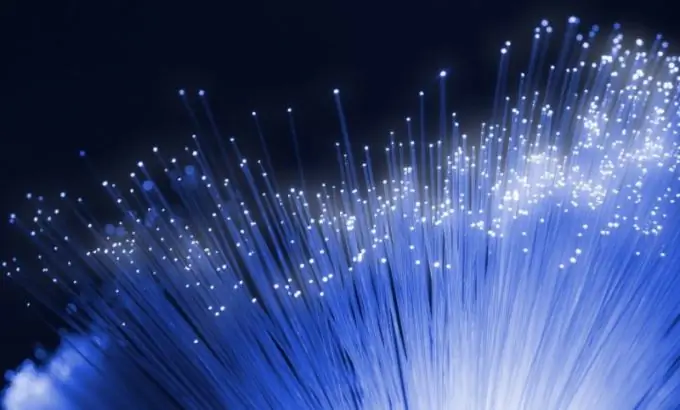- Author Lauren Nevill [email protected].
- Public 2023-12-16 18:48.
- Last modified 2025-01-23 15:15.
Fiber-optic communication is a method of information transmission in which fiber-optic cables are used as guiding systems, and electromagnetic radiation in the optical range plays the role of a signal carrier. Of all existing communication systems, fiber optic lines have the highest bandwidth, which can be measured in terabits per second.

Fiber optic device
A fiber optic cable consists of a glass fiber serving as a center conductor of light, surrounded by a glass sheath with a lower refractive index than the center conductor. The light beam, formed by a diode or semiconductor laser, propagates along the center conductor, without leaving it due to the glass envelope.
On April 22, 1977, in Long Beach, California, General Telephone and Electronics first used optical fiber to carry 6 Mbps telephone traffic.
History of creation
The very technology of data transmission using optics is not particularly complicated and was developed for a long time. Back in 1840, scientists Jacques Babinette and Daniel Colladon conducted an experiment with a change in the direction of the light flux by refraction. In 1870, John Tyndall published a work on the nature of light, in which he referred to an experiment conducted by Babinette and Colladon. The first practical application of the new technology was in the 20s of the XX century. Then two experimenters John Bird and Clarence Hasnell demonstrated to the scientific public the possibility of transmitting images through optical tubes. This opportunity was used by Dr. Heinrich Lamm to examine patients.
The first fiber optic cable was invented and created as a result of a series of experiments in 1952 by physicist Narinder Singh Kapani. He created a rope of glass filaments, with a core and a cladding, which had different refractive indices. The cladding in the Kapani cable served as a mirror for the more transparent core, which solved the problem of fast scattering of the light beam. Due to this, the light beam began to reach the end of the optical fiber, which made it possible to use this method of data transmission over long distances.
In 1960, with the invention and development of sufficiently compact semiconductor GaAs lasers, the problem with the light source was solved. In 1970, specialists from Corning Incorporated created a high-quality fiber optic cable that does not use repeaters in its work. The emergence of these inventions gave a powerful impetus to the development of a new promising type of wire communication.
The cost of using fiber optic technology is reduced, which makes this service competitive with traditional services.
Today, fiber-optic cable is the fastest way to transfer data; it is used to establish high-speed Internet lines, in medicine and many other areas. Fiber optic is laid across continents and along the ocean floor for tens of millions of kilometers, but even this does not affect the high data transfer rate. Therefore, despite the rather high cost of equipment and tools, fiber-optic technologies continue to actively develop and are the most popular way to quickly transfer information.






